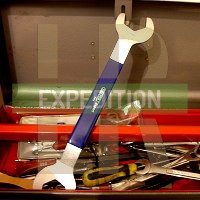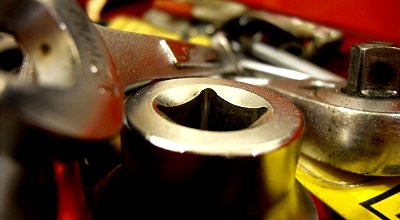Tool Management
After you get your first Land Rover Defender and you're starting to learn about where you can save money by doing things yourself, you realise that for every task there is something you lack. Namely, tools.
If you don't have much of a resplendent toolbox when you first get your Land Rover, then you start to realise that the list of required tools grows rapidly. If you're not into self repair then maybe this isn't an issue, but if you intend to go on expedition with your Land Rover then being able to look after your vehicle is a must.
As i've been getting more adventurous with mechanical tasks, lots of new things require certain tools and it's now getting to the point where my toolbox is getting very full. You start off with the obligatory socket set, spanners and screwdrivers, but they very quickly run out of things to do. Want to adjust the door strikers? Get some torx allen keys. Want to replace the door hinges? Get an impact driver. Want to replace the track rod? Get a ball joint splitter. Want replace a transfer box seal? Get a 30mm socket. Want to tighten a bolt correctly? Get a torque wrench. The list goes on with every new task I want to dip into.
Whilst at home you may have all the tools to your heart's content, but carrying all of them on expedition will take a lot of space and increase the weight you carry substantially. Consolidation is the key.
Starting out
I can recommend getting a good selection of tools when you start to work on your Land Rover. The up front cost would probably be in the region of £3-400, but if you're serious about working on your vehicle then you'll spend this eventually anyway.
Get a good selection of tools right from the beginning of working on your Land Rover!
It saves lots of trips to Halfords on a Sunday afternoon because you don't have the right tool! I've done this too many times and had to abandon many jobs because of this.
Dual purpose
Recently, I've wanted to change the gearbox oil in my LT77. The main casing drain plug is 32mm and the extension case is 24mm. So I bought a large adjustable spanner with markings up to 35mm. Unfortunately, it only goes as wide as 31mm. Typical! That's cheap tools for you.
 I didn't want a 32mm socket as they don't fit without some metal butchery (due to the propshaft location), so I knew i'd have to get the proper spanner. However, I had also been planning on removing the Viscous fan to check the auxilliary belts, and noticed that on a 200Tdi (and 300Tdi) it's also 32mm. The Viscous fan can only be removed with the proper spanner (if you want to do it properly) as it has an offset end to get at the fan nut.
I didn't want a 32mm socket as they don't fit without some metal butchery (due to the propshaft location), so I knew i'd have to get the proper spanner. However, I had also been planning on removing the Viscous fan to check the auxilliary belts, and noticed that on a 200Tdi (and 300Tdi) it's also 32mm. The Viscous fan can only be removed with the proper spanner (if you want to do it properly) as it has an offset end to get at the fan nut.
I realised the connection between the two tasks and I bought the Viscous spanner that can also be used on the gearbox drain plug. The spanner is double ended and also has a 36mm end.
So what I now have is the usefulness of 3 tools, 32mm spanner, 32mm viscous fan wrench and a 36mm spanner - all from one tool. This may not be much of a revelation to most people, but it highlights an important mindset for planning your expedition.
As far as possible, try to make every bit of equipment you take perform more than one function.
This way you save on weight and cost.
A penknife is the epitome of this concept, but thinking more laterally you could use your Platypus hydration as a shower, a Hi-lift jack as a ratchet winch, a wide necked water bottle can be used as a container or a prybar can be used as a ball joint splitter.
The planning process of an expedition is all about that. Planning. It'll help in the long run. Because when you're up to your axles in mud and darkness is falling, you don't want to be trying to find your tools in amongst a sea of unnecessary fluff. It'll also reduce the equipment that you don't need to make more room for the equipment that you DO need.
What other suggestions do you have of items that can double up on expedition?
